Bill Brandt's best-known work documents the vivid social contrasts in Britain during the World Wars. He also photographed the landscapes of 'Literary Britain' and a pantheon of great artists and writers.
Photographing the English
The extreme social contrast, during those years before the war, was, visually, very inspiring for me. I started by photographing in London, the West End, the suburbs, the slums.
Brandt visited England during the late 1920s, and he and his first wife, Eva, settled in Belsize Park, north London, in 1934. He adopted Britain as his home and it became the subject of his greatest photographs. The majority of Brandt's earliest English photographs were first published in his 1936 photobook, The English at Home.
The young photographer used his family contacts – for example, his wealthy banker uncles – to gain access to a variety of subjects. The book contained a number of pointed social contrasts, such as the high-life presented on the front cover, and the poor family shown on the back cover.
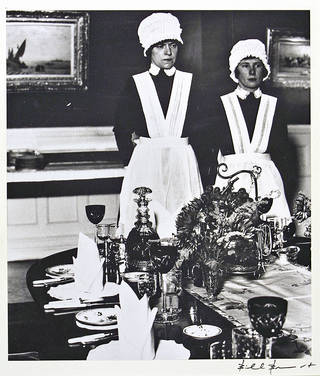
The photograph Parlourmaid and Under-parlourmaid Ready to Serve Dinner was taken in the house of one of Brandt's banker uncles. The American photographer Walker Evans remarked about this photograph, "This is Bill Brandt striking home in every sense".

Night photography
I photographed pubs, common lodging houses at night, theatres, Turkish baths, prisons and people in their bedrooms. London has changed so much that some of these pictures now have a period charm almost of another century.
Brandt's second photobook, A Night in London, was published in London and Paris in 1938. It was based on Paris de Nuit (1936) by the French photographer Brassaï. The book tells the story of a London night, moving between different social classes and again made use of Brandt's family and friends.
Night photography was a new genre, opened up by the newly developed flashbulb (the 'Vacublitz' was manufactured in Britain from 1930), although Brandt generally preferred to use portable tungsten lamps called 'photo-floods'. Brandt also often used the darkroom to alter his photographs in decisive ways, using the 'day for night' technique employed by cinematographers to transform images photographed in daylight into night scenes.
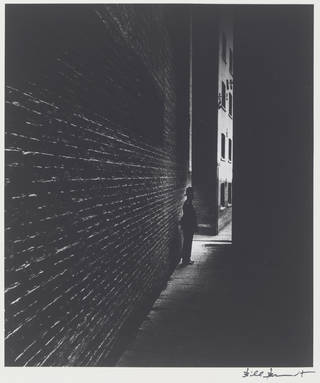
The North
Spurred by the Jarrow Crusade of 1936 (a march from Jarrow in north-east England to London in protest against unemployment and poverty) and from reading George Orwell's essays and J.B. Priestley's book An English Journey (1934), Brandt visited the industrial north of England for the first time in 1937.
The effects of the Depression and the closure of shipbuilding yards in the north-east had resulted in an 80 percent unemployment rate. When he was there, Brandt carefully documented the act of 'coal-searching' – the retrieval of small lumps of coal from spoil heaps – and the domestic life of miners.
His photograph Coal-searcher Going Home to Jarrow eloquently captured life in northern England during the Depression. It was published in Picture Post a decade later to symbolize a very different time – the onset of the post-war 'Age of Austerity.'
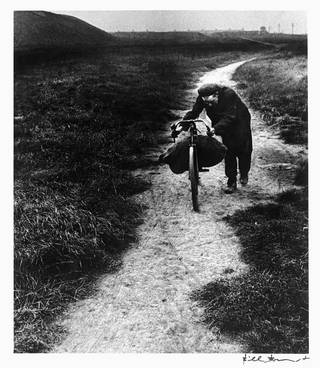
He was pushing his bicycle along a footpath through a desolate wasteland between Hebburn and Jarrow. Loaded on the crossbar was a sack of small coal, all that he had found after a day's search on the slag-heaps.
Photojournalism during the Blackout and Blitz
In 1939, at the beginning of the war, I was back in London photographing the blackout. The darkened town, lit only by moonlight, looked more beautiful than before or since.
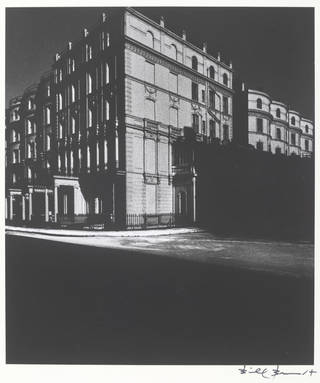
Bill Brandt met Tom Hopkinson, then assistant editor of Weekly Illustrated, in 1936. Hopkinson, later knighted for services to journalism, became Brandt's editor at Lilliput and Picture Post magazines. Brandt would propose picture-stories for both magazines and often sequence his own photo-essays, sometimes also contributing text.
The blackout photographs were probably Brandt's own idea, and were made during the 'phoney war' period in 1939, after war had been declared but before serious hostilities between Britain and Germany had begun. A second set of blackout photographs were made in 1942.
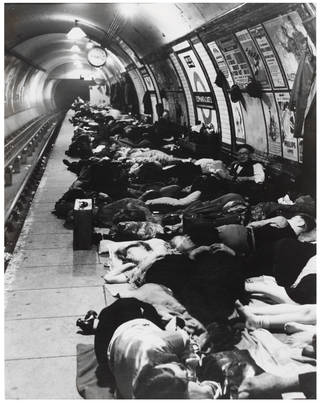
After the London Blitz began in 1940, Brandt was commissioned to record bomb shelters by the Ministry of Information. His photographs were sent to Washington as part of the British government's attempt to bring the US into the war on the allied side.
Landscape and literature in Britain
During the World Wars, suspended social life, long railway journeys and the need to reaffirm ideas of national identity all encouraged a return to the literary classics. Brandt shared in this. He read and admired the writings of the Brontë sisters, Thomas Hardy, George Crabbe and John Clare, some of whose poems he knew by heart.
From 1945 onwards Brandt contributed a series of landscape photographs, accompanied by texts selected from British writers, to Lilliput, a British monthly magazine, founded by the photojournalist Stefan Lorant, that focused on short stories, humour, photography and art. Other landscapes appeared in Picture Post and the American magazine Harper's Bazaar.
Brandt waited years for the opportunity to photograph Stonehenge under snow. His image provided the cover for the issue of Picture Post for 19 April 1947. The issue dealt with Britain in crisis, as post-war euphoria gave way to the 'Age of Austerity'.

Although he never met Brandt, the novelist Lawrence Durrell attempted to persuade the leading poetry publishers, Faber & Faber, to publish Brandt's landscapes. In 1950 the publishers Cassell commissioned Brandt to complete the series, which was published as Literary Britain in 1951, with an introduction by John Hayward.
Portraits
I always take portraits in my sitter's own surroundings. I concentrate very much on the picture as a whole and leave the sitter rather to himself. I hardly talk and barely look at him.
Although Brandt's career began, decisively, with his close-up portrait of Ezra Pound in , portraiture became more of a focus in his career only in the 1940s.
He used a Rolleiflex (introduced in 1928): its ground glass provided a clear view of the subject and the 2 ¼ x 2 ¼ inch negative gave Brandt the latitude he liked for darkroom work, especially cropping.
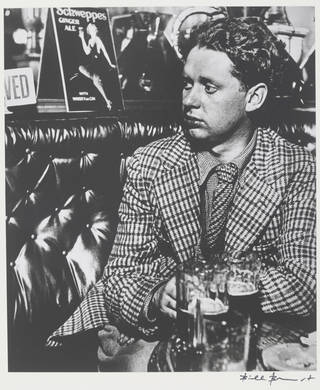
The portraits were commissioned by Lilliput, Picture Post and Harper's Bazaar. His portrait of Dylan Thomas appeared in a feature on 'Young Poets of Democracy' in Lilliput in December 1941. 'A Gallery of Literary Artists' appeared in the same magazine in November 1949, including the Sitwells, Robert Graves, Norman Douglas, E.M. Forster and Graham Greene. Lilliput also published portraits of visual artists and composers.
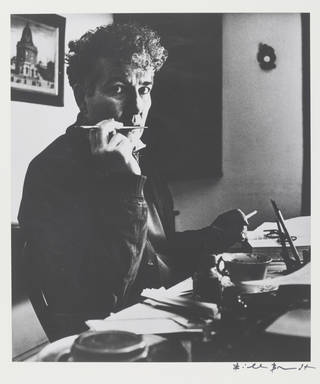
In the 1960s Brandt used a Hasselblad camera with a Superwide-angle lens, which gave his portraits a dynamic edge appropriate to the new decade.
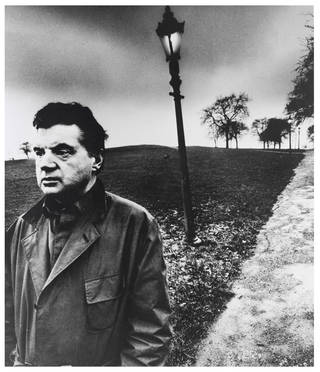
Nudes
Instead of photographing what I saw, I photographed what the camera was seeing. I interfered very little, and the lens produced anatomical images and shapes which my eyes had never observed.
Bill Brandt experimented with photography of the nude in the 1930s and early 1940s but made a decisive breakthrough in 1944 when he acquired a mahogany and brass camera with a wide-angle lens. He enthusiastically acknowledged a debt to the wide-angle, deep-focus cinematography of Orson Welles' film Citizen Kane (1941). His wide-angle camera, a 1931 Kodak used by the police for crime scene records, allowed him to see, he said, "like a mouse, a fish or a fly".

The nudes reveal Brandt's intimate knowledge of the École de Paris – particularly Man Ray, Picasso, Matisse and Arp – together with his admiration for Henry Moore. He published the photobook Perspective of Nudes in 1961. It featured nudes in domestic interiors and studios, on the beaches of East Sussex and northern and southern France. He used a Superwide Hasselblad for the beach photographs. In 1977 – 8, Brandt added further nudes, published in Nudes, 1945 – 80. For his nudes Brandt used professional models, but also sometimes family and friends.
Teaching and curating
Brandt's last years were spent reissuing his work in a series of books published by Gordon Fraser. He taught photography students at the Royal College of Art and continued to accept commissions for portraits.
He selected an exhibition for the Victoria and Albert Museum titled The Land: 20th Century Landscape Photographs (1975) and was working on another show, Bill Brandt's Literary Britain, when he died after a short illness in 1983. The exhibition became a memorial tribute to Brandt when it opened the following year.
Discover more about Bill Brandt.


